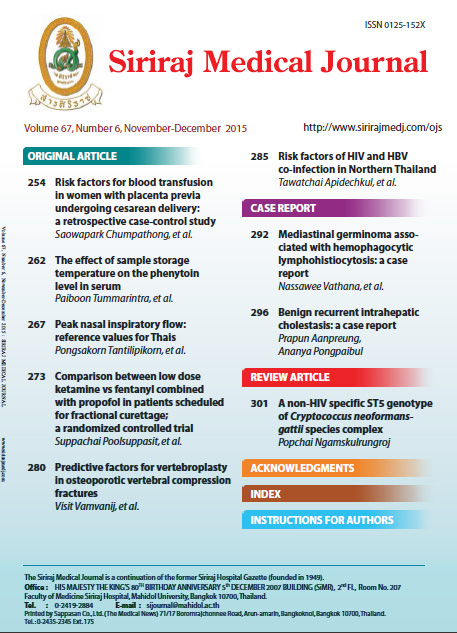Risk Factors of HIV and HBV Co-infection in Northern Thailand
Abstract
Objective: To identify the risk factors of HIV/ HBV coinfection among HIV persons.
Methods: 356 newly diagnosed HIV positive patients had their blood tested for HBV serological markers: HBsAg, HBsAb and HBcAb by immunochromatographic and ELISA methods. Cases were those positive for one or more of the HBV markers, and controls were negative for all HBV markers. All completed questionnaires designed to identify risk factors. Logistic regression statistical method was used to find the associations between demographic and behavioural parameters and the coinfection status.
Results: A total of 122 out of 356 cases were suitable for analysis. Fifty percent were male, 40.3% were aged 30-39 years old, 62.9% were married, 18.6% were illiterate, and 10.5% were unemployed. After controlling for possible confounding factors the multiple logistic regression identified two factors associated with HIV/HBV co-infection namely number of years in school and CD4 cell count. The “no education” group had a greater risk of 7.07 times (OR=7.07, 95% CI=1.77-28.24) than the “≥13 years” group. CD4 “≤200 cells/mm3”was a protective factor protect for HIV and HBV coinfection when compared to “≥ 200 cells/mm3” group (OR=0.35, 95% CI=0.13-0.94).
Conclusion: The study suggests that a good education may reduce HIV/HBV co-infection. A practical approach would be a provision of wide accessibility to quality general and sex education on the risk and prevention of HIV, HBV, and a promotion of HBV immunization.
Keywords: HBV-HIV Co-infection, risk factors, CD4, Thailand
Downloads
Published
How to Cite
Issue
Section
License
Authors who publish with this journal agree to the following conditions:
Copyright Transfer
In submitting a manuscript, the authors acknowledge that the work will become the copyrighted property of Siriraj Medical Journal upon publication.
License
Articles are licensed under a Creative Commons Attribution-NonCommercial-NoDerivatives 4.0 International License (CC BY-NC-ND 4.0). This license allows for the sharing of the work for non-commercial purposes with proper attribution to the authors and the journal. However, it does not permit modifications or the creation of derivative works.
Sharing and Access
Authors are encouraged to share their article on their personal or institutional websites and through other non-commercial platforms. Doing so can increase readership and citations.










